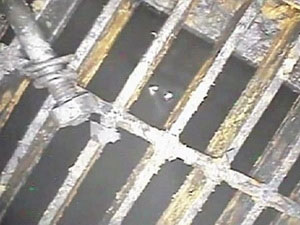Detection of ultra-high levels of radiation at Fukushima 1
On October 10, Tokyo Electric Power Company (TEPCO) announced measurements at the No.1 reactor of the Fukushima 1 Power Plant, whereby the radioactive concentration measured by the radiation meter in the inner area. the reactor containing 11.1 sievert (Sv) / hour (1 sievert = 1,000 miliSievert).

The image of the reactor's iron bolt and bottom net in the video obtained from TEPCO's endoscope camera at the No.1 reactor.
This is the highest level that TEPCO measured so far, while the surface water concentration is 500 milliSievert (mSv) / hour.
Previously, on June 27, TEPCO announced to measure radiation levels up to 10.3Sv / h in the area outside the pressurized room inside the No. 1 reactor house.
Typically, a person exposed to 1,000mSv of total radiation exposure will exhibit acute radioactive shock such as vomiting and will die if the radiation concentration exceeds 10,000mSv.
The limited exposure of a plant technician is 50mSv / year if it is in an environment with a radioactivity level at this level, it will only work for 20 seconds and appear the following acute radioactive shock manifestations 6 minutes.
Besides the measured radiation levels, TEPCO also said the water level inside the reservoir is 2.8m higher than expected about 80cm.
TEPCO spokesman Masayuki Ono said after the latest investigation that it was difficult to pinpoint the location of the molten fuel inside the reservoir but said TEPCO would not change the plan to dismantle the reactor. this.
The power company also released a video footage of the reactor storage tank obtained from the endoscopic camera the day before.
In this video, a bolt with a diameter of about 10mm is found in the iron in the reactor, but Mr. Ono said the bolt could not be something that came out of a large object because of its size. small, at the same time, he affirmed that the image inside the tank is 'fine' despite the fact that the base and other locations show signs of corrosion.
TEPCO is conducting a series of measurements at this reactor storage tank from October 9. The company also plans to sample water in the oven on October 12 - the first time since the nuclear disaster in March 2011.
The Number 1 reactor was one of three reactors that caused melting of fuel rods and the possibility of this fuel melting and leaking through the high pressure tank and lumping at the bottom of the reactor tank. .
Currently TEPCO continues to pump water into these three reactors to maintain the low temperature of the fuel but a large amount of contaminated water has leaked from these tanks out.
- Unusually high radiation detection in the Japanese capital
- Accumulated contamination of Fukushima workers is still high
- Decontamination work around the Fukushima Plant was three years late
- Detection of ultra-high-level contaminated fish near Fukushima 1
- Japan seeks to reduce radiation levels in Fukushima
- Very high radiation index at Fukushima
- Radiation from Fukushima is only 10% of the Chernobyl case
- Radiation to extremely high levels in the reactor in Japan
- Japan: Robot radiation resistance incident
- Radiation detection is 10 times higher in Japan
- Products from Fukushima no longer trace radiation
- Detection of Fukushima radiation on the Canadian coast
 Is the magnetic North Pole shift dangerous to humanity?
Is the magnetic North Pole shift dangerous to humanity? Washington legalizes the recycling of human bodies into fertilizer
Washington legalizes the recycling of human bodies into fertilizer Lightning stone - the mysterious guest
Lightning stone - the mysterious guest Stunned by the mysterious sunset, strange appearance
Stunned by the mysterious sunset, strange appearance